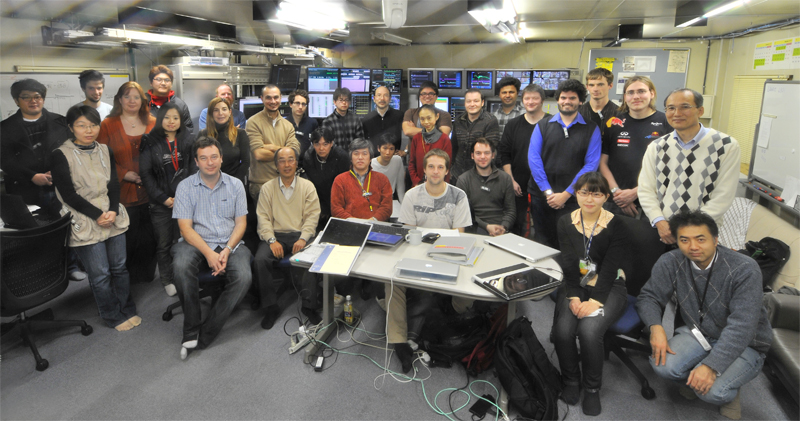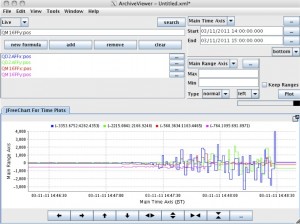As of this month, nine months have passed since the Great Eastern Japan earthquake, also known as the 3.11 Earthquake. Restoration of the Accelerator Test Facility (ATF) is in its final stage at KEK, Japan, where the ATF2 project, the final focus test beam for ILC, is being conducted with an international collaboration.
The geological points of Japan’s islands have moved on an unprecedented scale, up to 1.2 metres (m) horizontally and 5.2 metres vertically, because of the earthquake. Even the KEK site has sunk down by about 10 centimetres (cm) and has moved about 50 cm eastward, shifts that are evidenced in the GPS measurements by The Geospatial Information Authority of Japan.
On that ground-shifting day, ATF was in operation for a short while even after the earthquake occurred, at 14:46:23 local time on 11 March. The archived beam position monitor (BPM) records from one of the quadrupole magnets BPMs, with data taken from the onset of the earthquake until the beam was manually aborted a few seconds afterwards is shown in Figure 1. The propagation time of the earthquake is estimated to have been 46 seconds. Its velocity was measured to be 8 kilometres per second at KEK, which is about 320 km from the earthquake’s epicentre,
Surprisingly, mechanical damage from the earthquake was not severe in the ATF and ATF2 beam lines despite the huge magnitude, while facilities such as power lines, the cooling water system severely suffered as described in an earlier ILC NewsLine article. All facilities were repaired by the end of May.
On 3 June, a test beam was sent through all beam lines up to the beam dump with a beam intensity of 0.3 x 1010 electrons/bunch after a rough alignment of the magnets, where the beams were confirmed by screens along the beam lines. The beam intensity increased to 1 x 1010 electrons/bunch for two weeks and the vertical emittance was measured to be about 30 picometres by the X-ray synchrotron radiation interferometer (XSR) at the damping ring (DR), where the accelerator was commissioned at nights and the alignment work was performed during the day.
We appreciated seeing 17 foreign colleagues from SLAC and University of Notre Dame (US), Royal Holloway University of London and Oxford University (UK), Laboratoire de l’accélérateur linéaire and Laboratoire Leprince-Ringuet (France) and Kyungpook National University (Korea), who came to participate in recovering the beam instrumentation devices and in the beam commissioning from May through August, just a few months only after 3.11.
Fine alignment was the major project to be completed for full recovery of ATF and ATF2. Personnel took care of alignment along the entire beam line, which consists of the injection linac (80 m long), the beam transport line (BT) from the linac to the DR, the DR (138 m of circumference) itself and the extraction / ATF2 beam line (98 m). All the beam lines were constructed on reinforced floors in different periods. We have noticed that the beam line gradually dipped into the linac end (a few millimetres) and jumped up at the BT before the earthquake. It was confirmed thanks to fine alignment work. Other beam lines were also surveyed by a laser tracker. The DR has a racetrack beam line lying from east to west. The racetrack was found to be about 1.5 mm wider in the north-south direction after the earthquake, though we could not conclude if this was because of the earthquake. Since the ATF2 floor is very newly constructed (September 2007), the floor sank down to about 1.5 mm with respect to the DR and it was also moved about 1 mm towards the DR after the earthquake.
All the observed displacements (actually magnets) were aligned within plus or minus 0.1 mm with respect to the design orbit. The fine alignment continued while beam operation took place during the day time in October 2011.
Starting in November, the accelerator was commissioned from the linac, BT and DR to the ATF2 beam line on a full scale. On 8 November, the beam intensity was recovered to 1 x 1010 electrons/bunch in the DR. The vertical emittance was measured to be 13 picometres by the XSR. In parallel, R&D on the Compton scattering cavity, on FONT, on the laser wire and the nanometre interaction point BPM resumed.

Daily operation meeting in the ATF control room, during the last week of operation of the year 2011. Image: KEK/Sakae Araki
Further fine alignment is being conducted by the beam-based alignment, especially in the DR and in the ATF2 beam line. Calibrations of the BPM system and the multi-optical transition radiation system were completed with verification of restoring performances in details.
Until 9 December, the interaction point beam size monitor, called the Shintake monitor, was not fully commissioned, since it is the most delicate device together with the very high-power laser.
This week is ATF’s last week of operation for this year, from 12 to 16 December. We have been commissioning the facility as much as possible. We should be able to demonstrate that the beam size is less than 300 nm, the smallest beam ever achieved in previous beam tuning. Our goal is to achieve 37 nm of vertical beam size at the focal point, denoted as the interaction point, by end of March 31, 2012.



Recent Comments